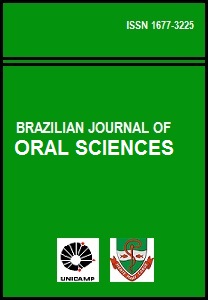Abstract
Aim: This study analyzed by scanning electronic microscopy (SEM) the quality of the apical obturation of a methacrylate based (polycaprolactone) root-canal filling system (Epiphany/Resilon) compared to that of an epoxy-resin based endodontic sealer (Sealer 26/gutta-percha). Methods: Twenty roots of human maxillary canines were debrided using ProTaper nickel-titanium rotary instruments and 2.5% NaOCl solution. The roots were divided into two groups (n=10): group I was sealed with Epiphany/Resilon and group II with Sealer 26/gutta-percha points. After set, the apical region of the roots was abraded until filling exposure and was then sectioned to obtain 2-mm–thick specimens. The specimens were analyzed by SEM and the images obtained were recorded and evaluated using an integration grid that permitted the quantification of the obturated area. Results: Statistical analysis (2-way ANOVA - Bonferroni test - p<0.05) revealed no significant difference (p>0.05) between the root canal filling systems. Conclusion: In conclusion, the two tested root canal filling systems showed similar behavior regarding to the quality of the apical obturation.The Brazilian Journal of Oral Sciences uses the Creative Commons license (CC), thus preserving the integrity of the articles in an open access environment.
Downloads
Download data is not yet available.

